How to Make a Table With ChatGPT
After the boom of ChatGPT and other large language models, we’ve seen a significant transformation in the way we perform tasks and handle information.
So far, we’ve witnessed OpenAI’s ChatGPT do wonders in revolutionizing our capabilities, offering help in various aspects of our daily life and work.
Since the day ChatGPT became publicly available, it has been used in all sorts of ways. From fixing gnarly bits of code, to sneakily helping out with essays, to even translating your favorite TV show quotes into Shakespearean English.
But there's one incredibly handy use of ChatGPT that doesn't get enough limelight—creating and organizing tables.
In this article, we're going to help you tap into this aspect of ChatGPT, and by the end, you'll be on your way to becoming a bonafide table magician. Let's dive in and start exploring how to use ChatGPT to handle those pesky tables and formulas like a pro!
How to ask ChatGPT to create tables
There are two ways to create tables with ChatGPT: You can either give your own data to ChatGPT and ask it to organize it into a table or ask ChatGPT to generate a table with sample data with a certain structure and parameters.
Below, we will explore what prompt you should give ChatGPT to make a table in ChatGPT in both ways.
Create tables in ChatGPT with your own data
- Feed your data to ChatGPT to create the table. The easiest way to enter your data is to put it into Excel or Sheets, paste it into ChatGPT, and prompt it to organize it into a table. However, if you don’t want to put your data into a spreadsheet, you can just insert your data in a descriptive way, order the items you want in the table, and describe to ChatGPT how to structure the table.
Prompt:
Please create a table with two rows. The first row should contain the following items: Monday, Tuesday, Wednesday, Thursday, and Friday, with the row title “Day of the week;” the second row should contain the following items: Gardening, Cooking, Drama class, Swimming, and Music class, with the row title “Activity.”
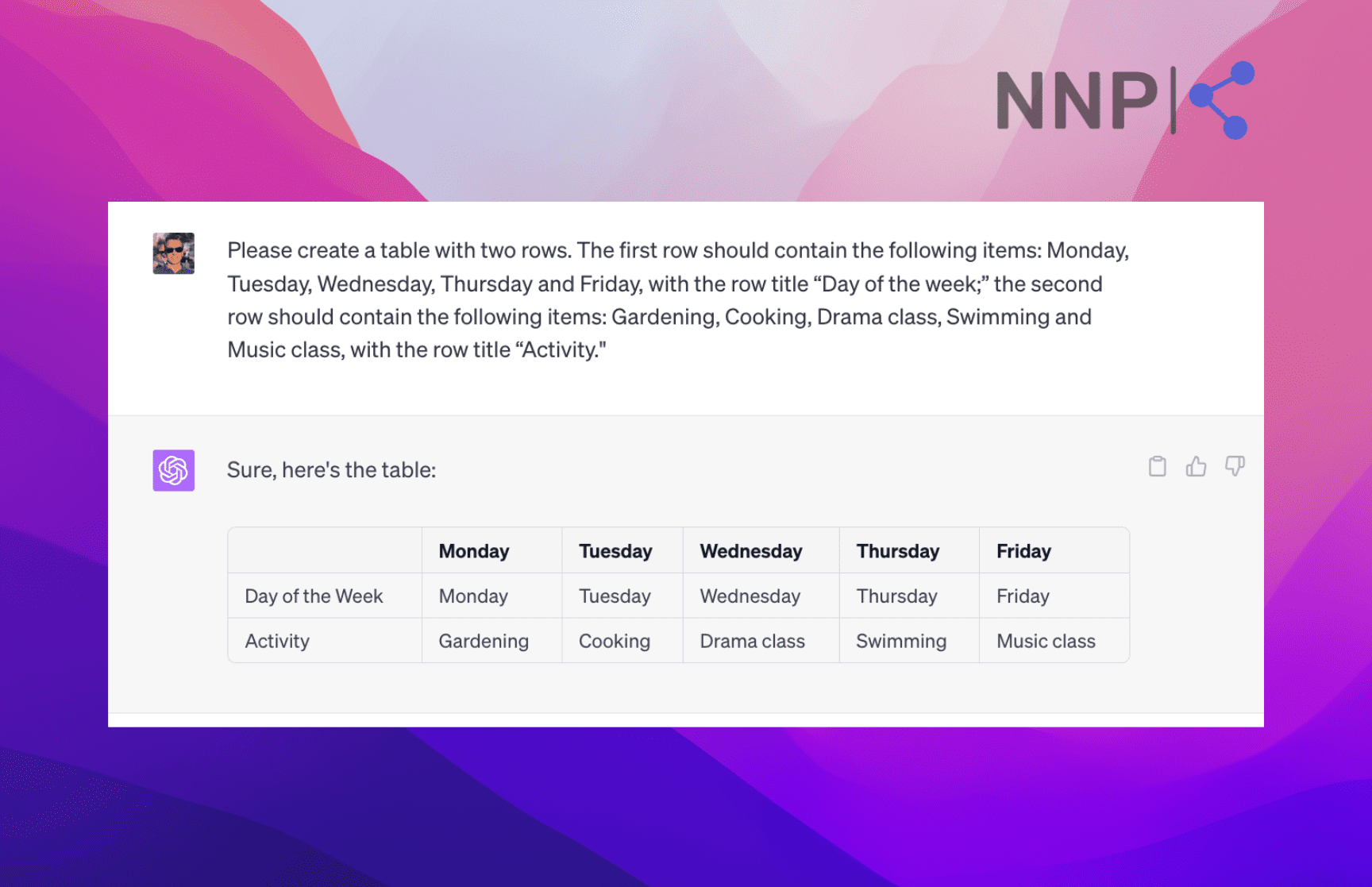
- Modify the table. After ChatGPT creates the first table, you can additionally prompt it to adjust the table by adding or removing items, rows, and columns.
Prompt:
Add one more row to the table with the row title “Cost” and add the following costs under each activity in order: $50, $25, $70, $15 and $80.
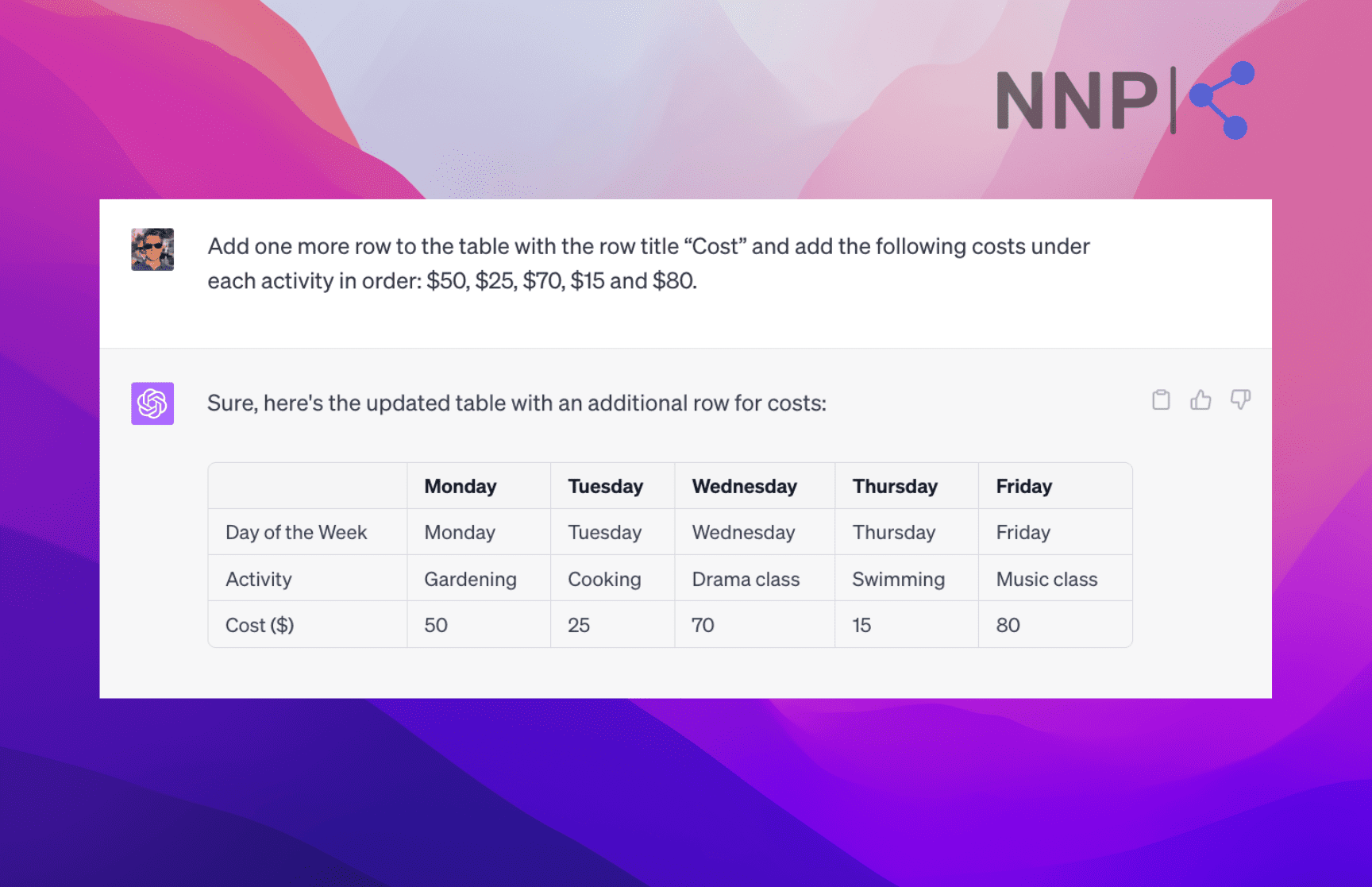
- Merge two tables. Based on your provided info, you can ask ChatGPT to create a new table and replace some of the items with new ones following the same logic. Then, prompt ChatGPT to merge the two tables into one.
Prompt:
Create a new table based on the above, but change the Activities with new ones following the same logic and add the respective cost. Next, merge the tables into one. Organize the table in Week 1 and Week 2, dividing the activities into Weeks.
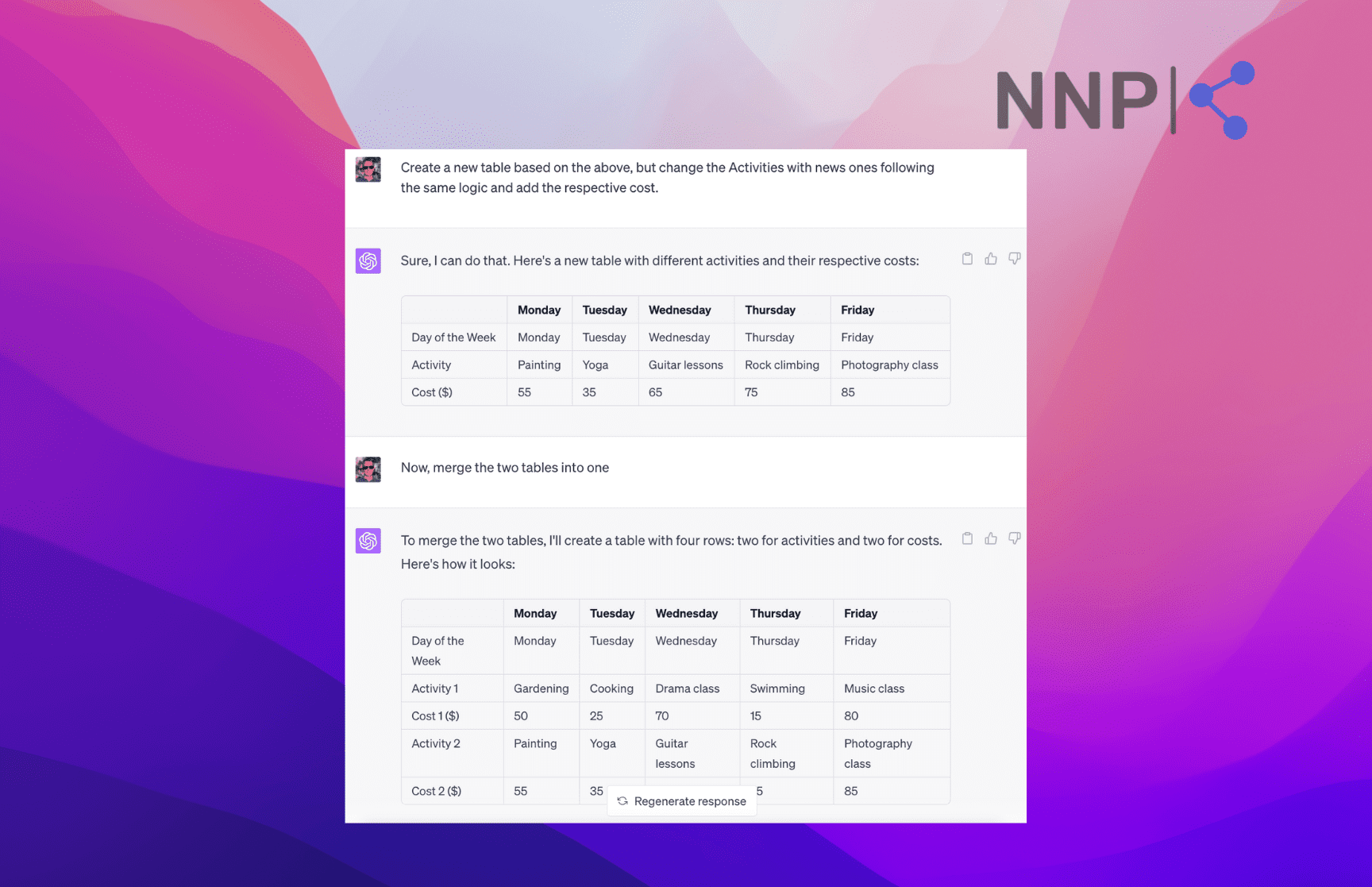
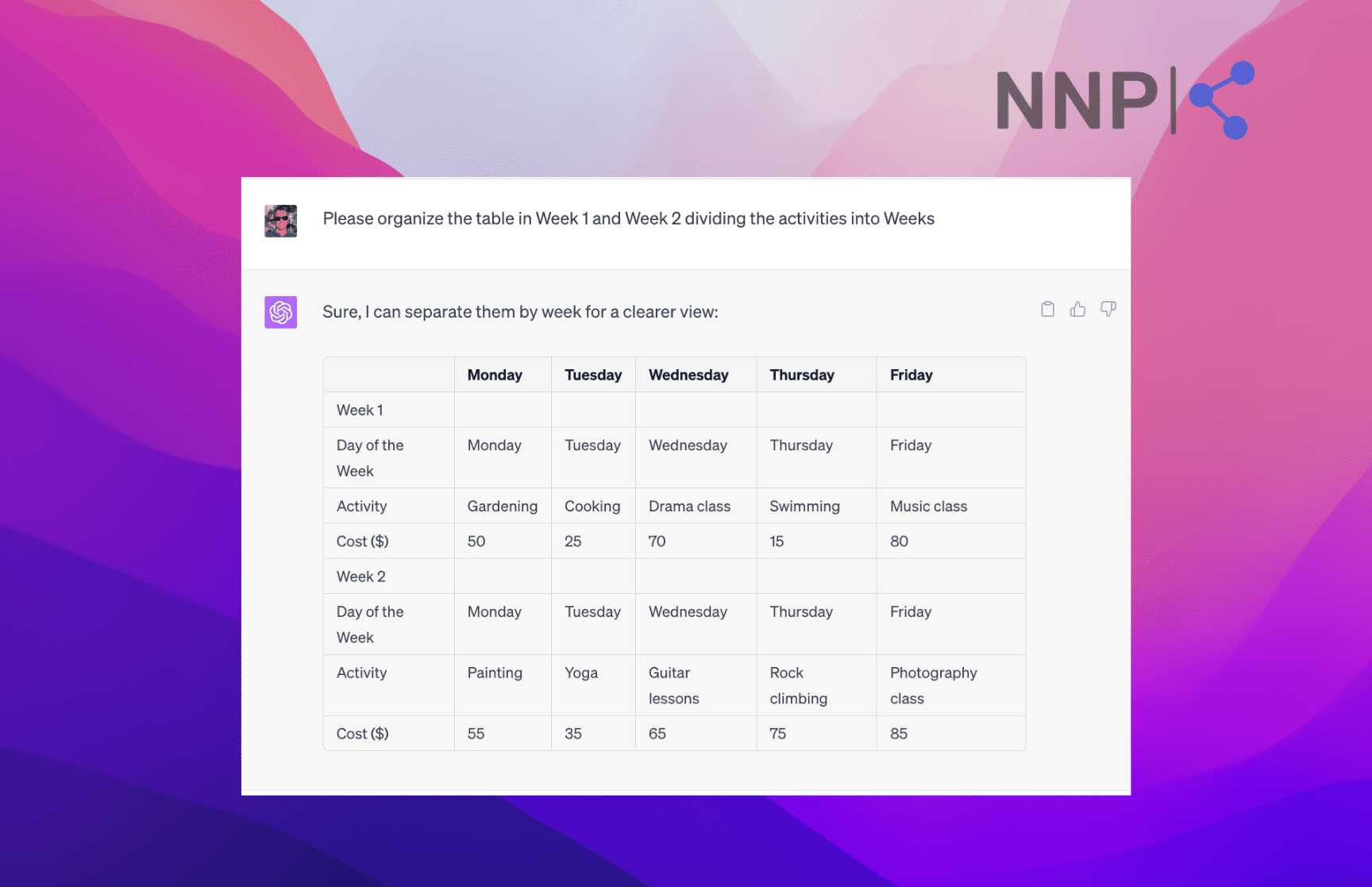
🔎 Check out what DAN ChatGPT is and how it works.
Create tables in ChatGPT with sample or generated data
If you don’t have your own data, or have no idea where to start, you can ask ChatGPT to create a sample table with generated data you can later use to customize.
- Ask ChatGPT to provide an example table and describe the type of information and table you need.
Prompt:
Please create an example company budget.
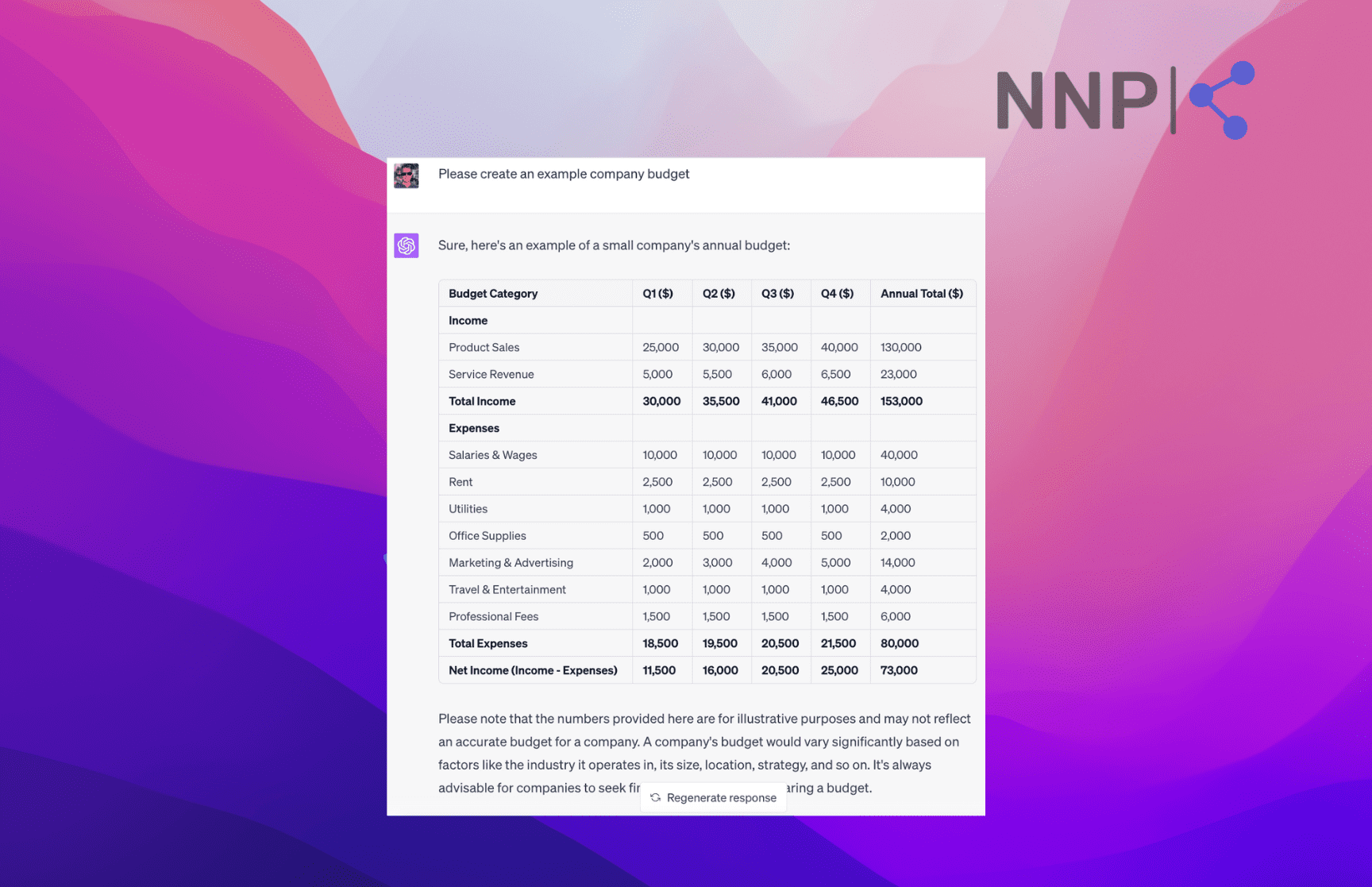
- Ask ChatGPT to provide an answer to a question in a tabular format. You might also ask ChatGPT a question that it can organize into a table.
Prompt:
Please list all movies Jennifer Lawrence has acted in her career, starting from the oldest to the newest one. Put the movies in a table with the title, release year, and Jennifer’s character.
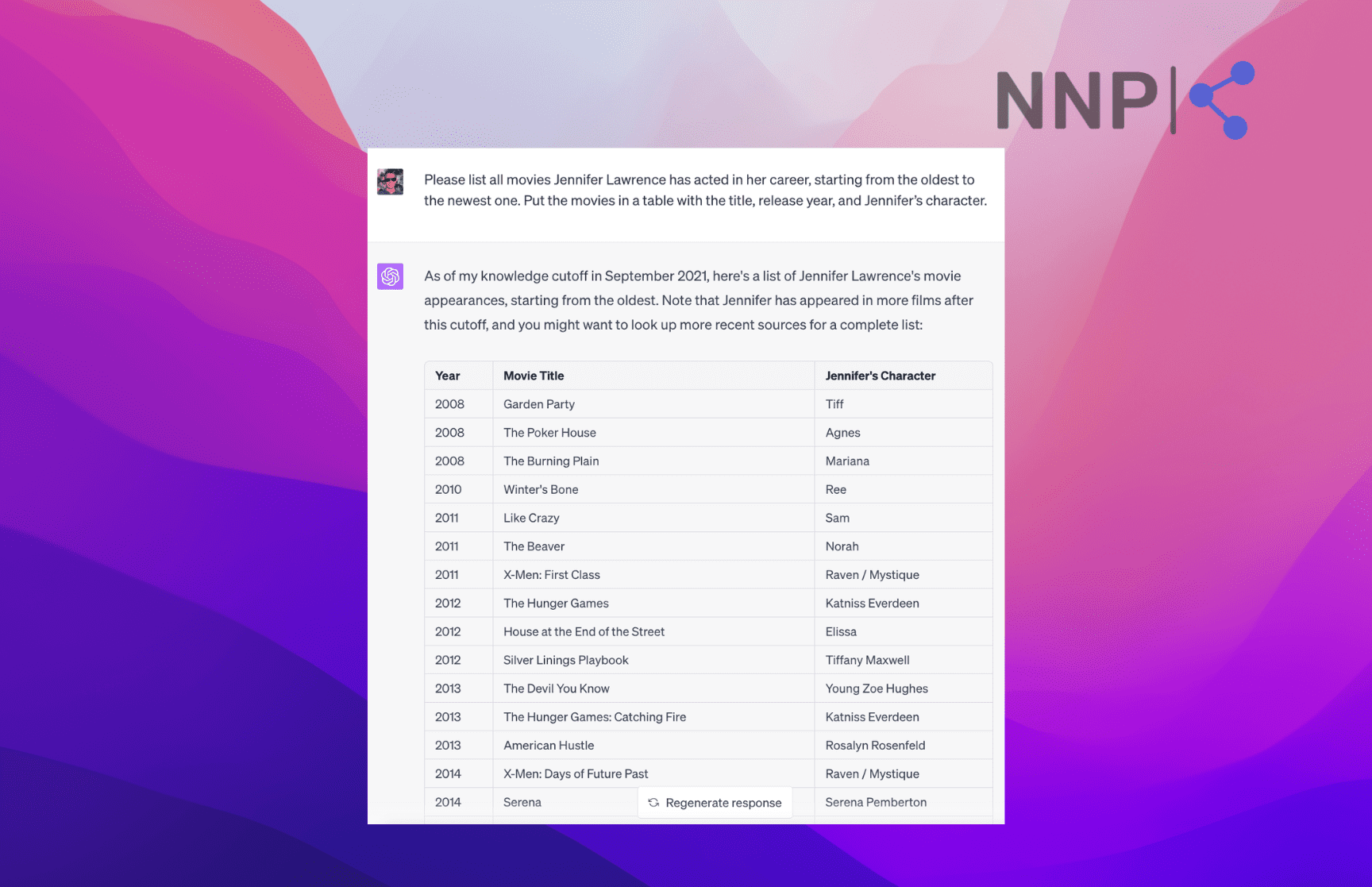
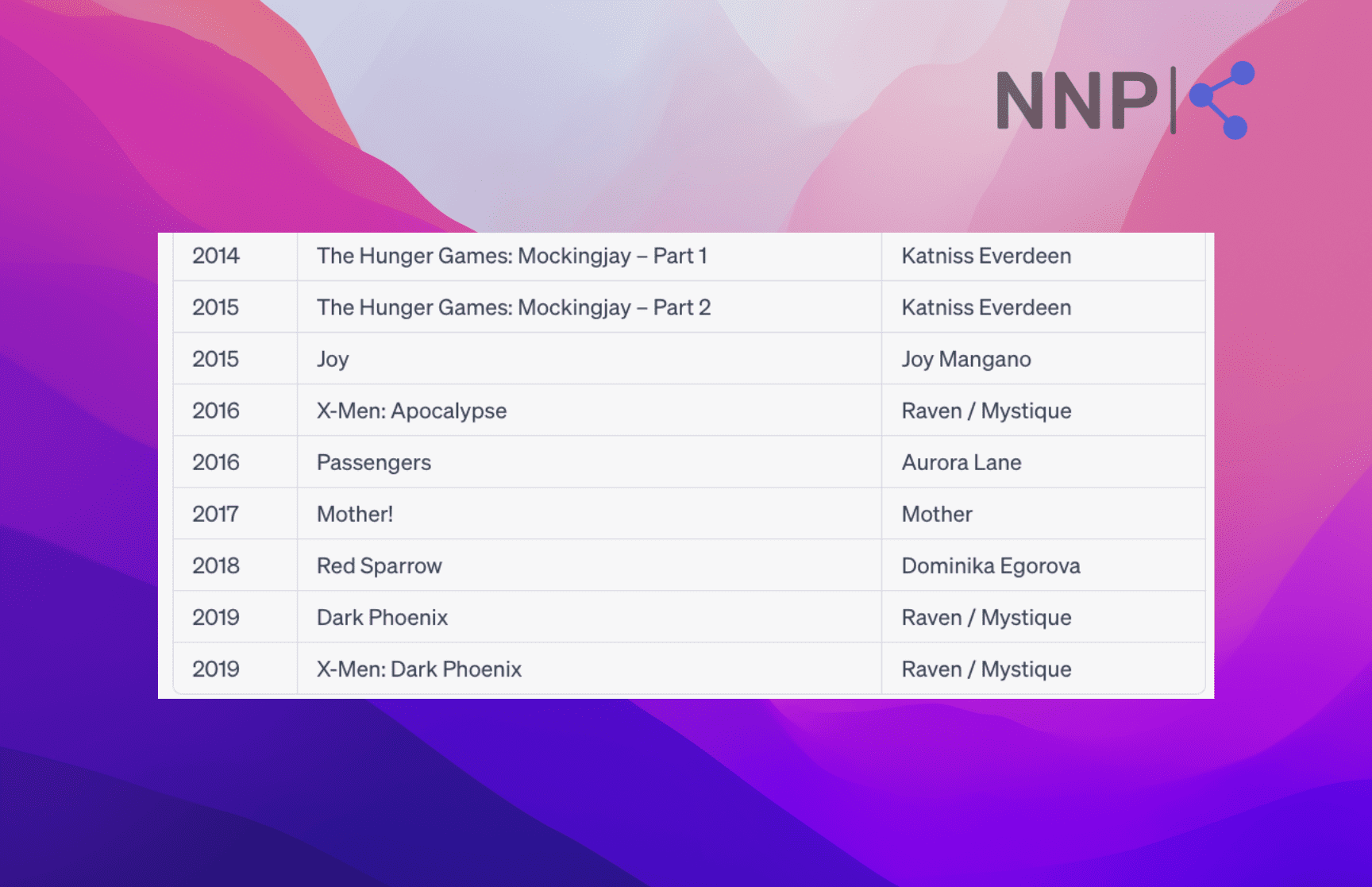
- Sort the table according to certain parameters/criteria. After generating the first table, prompt ChatGPT to add more parameters to the table and sort the table according to them.
Prompt:
Please also add the movies' box office earnings and sort the table starting from the highest-grossing movie to the lowest-grossing movie.
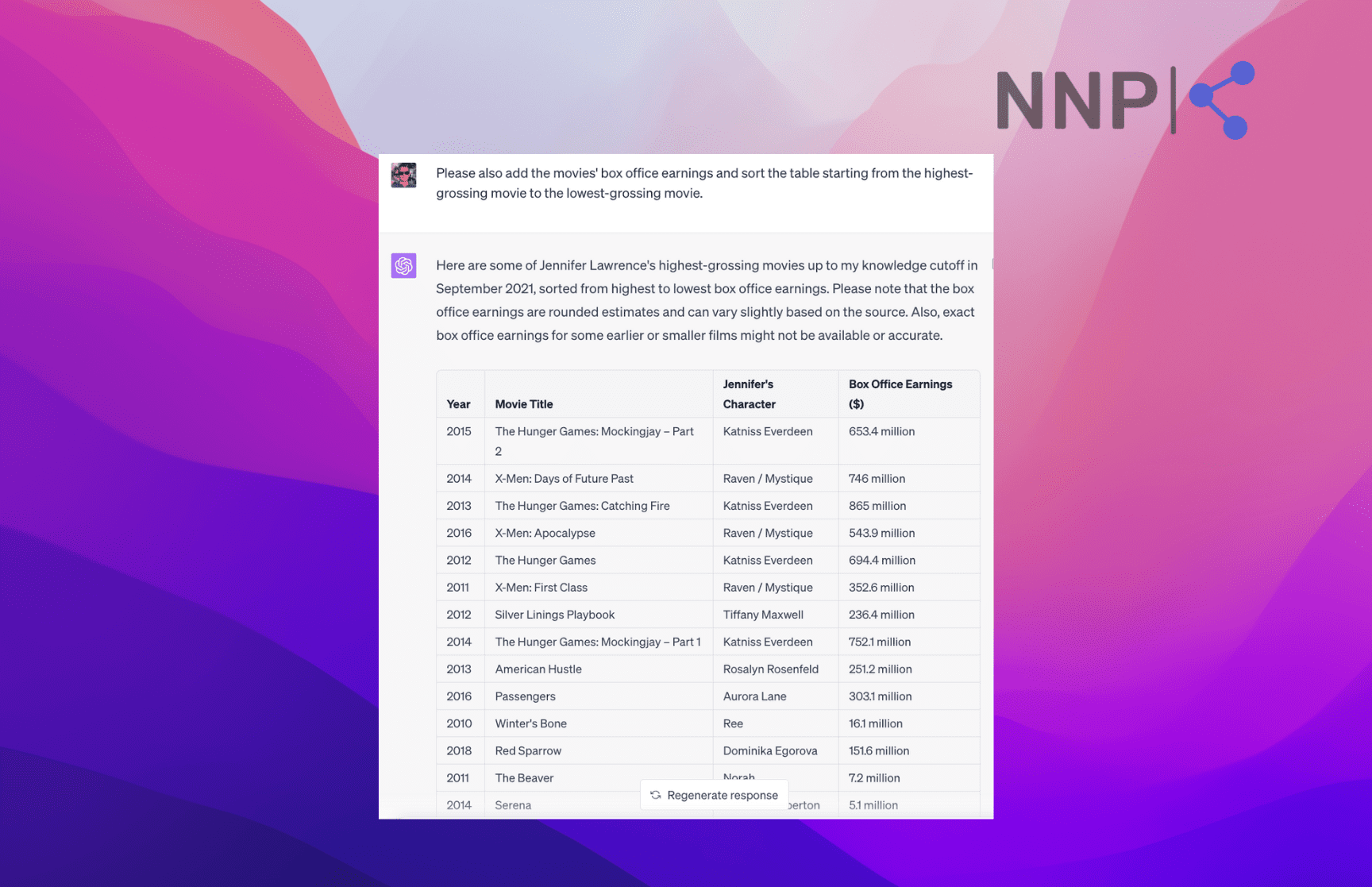
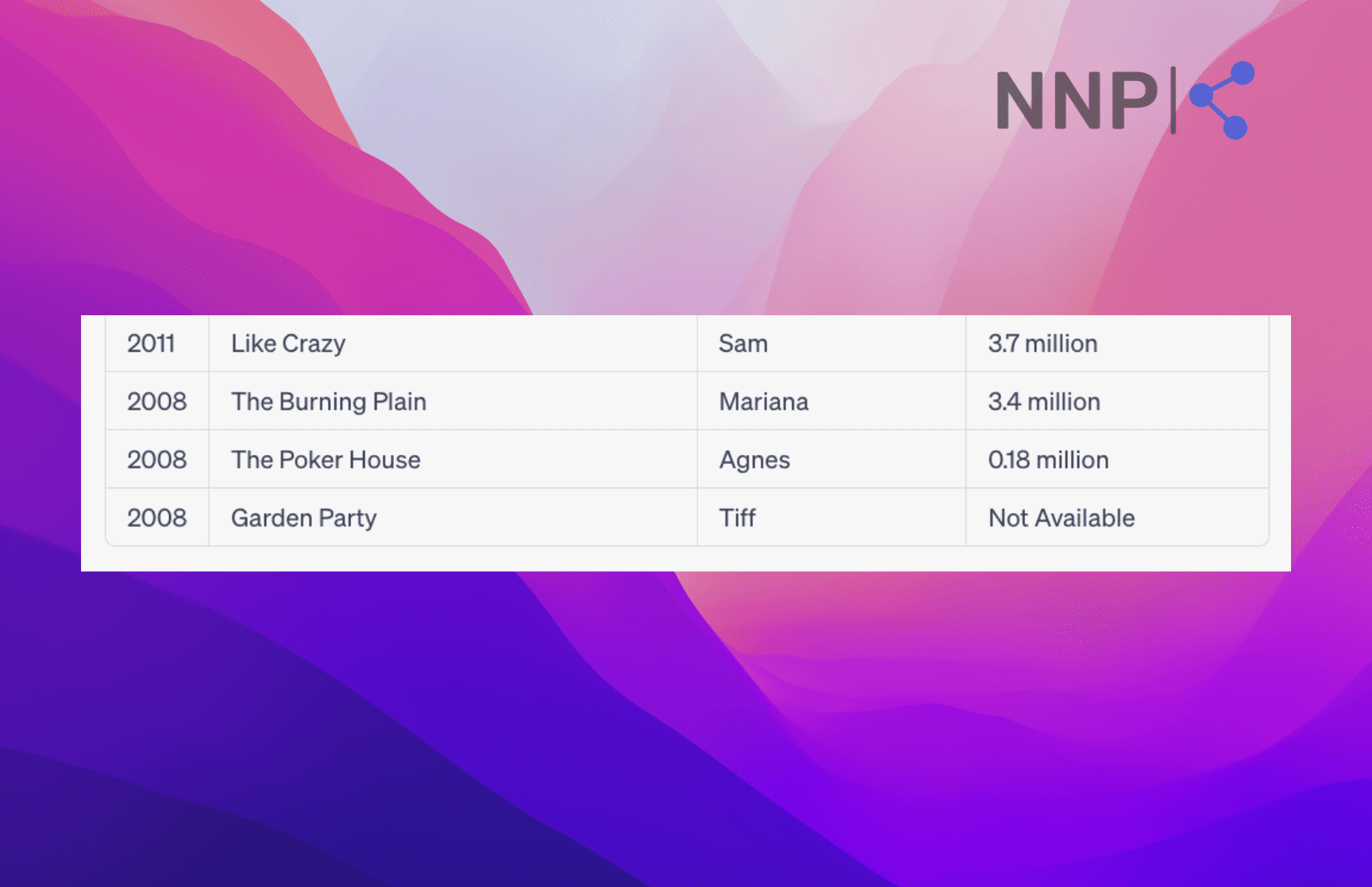
- Export the table. After creating the table, the final step is to add it to a document or page. However, if you have experience with working with tables, you’d know that just copying and pasting the table is not the appropriate way.
📈 You might also be interested in reading about the new Code Interpreter plugin.
Luckily, ChatGPT allows you to export the table in any format you need, regardless if you need to add it to Google Sheets, Excel, a website or a presentation. You can request ChatGPT to export the table in a format suitable for Excel, Sheets, JSON, XML, SVG, or others.
Prompt:
Please export the table into a JSON file.
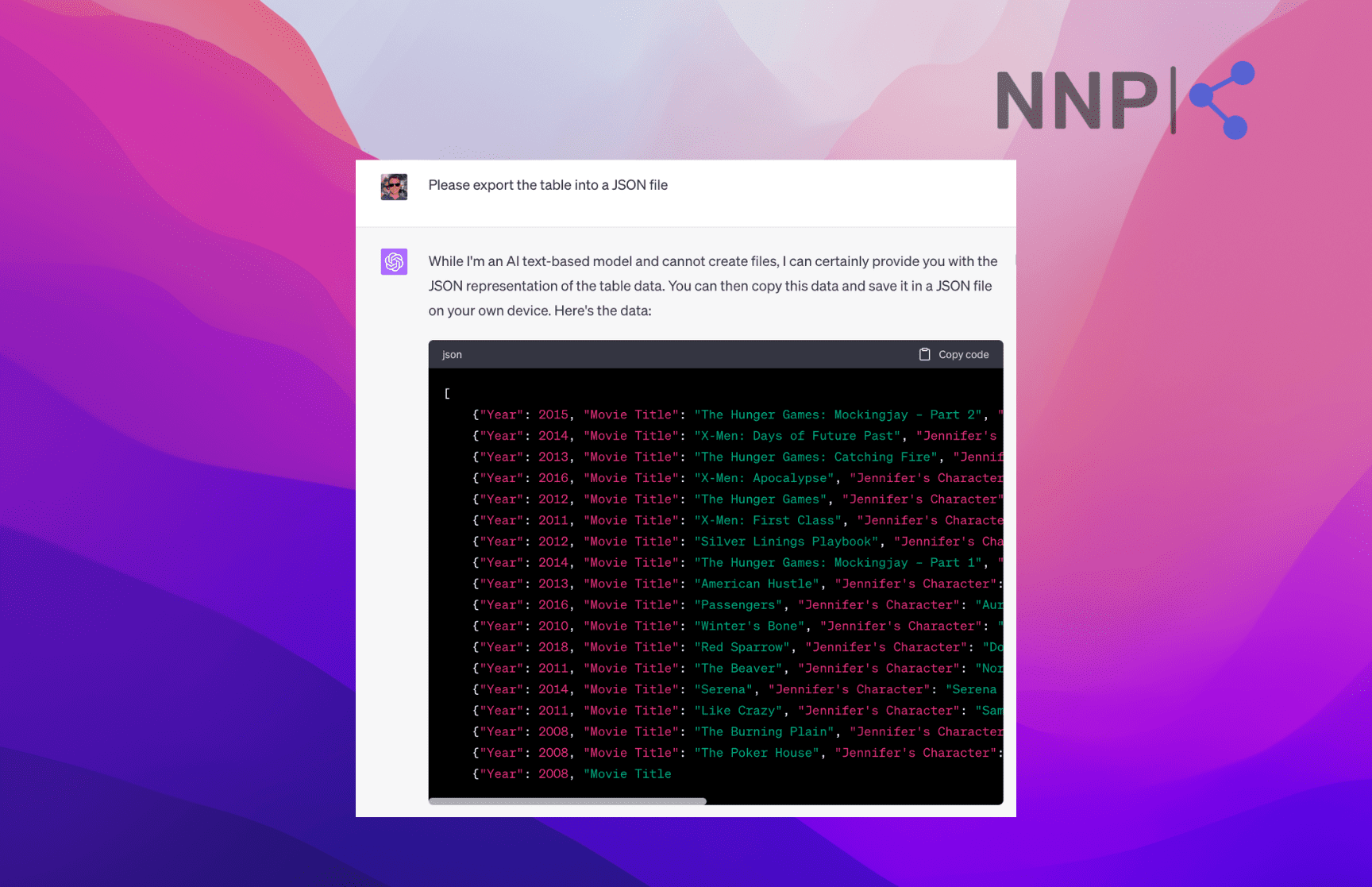
Note: You can perform this step on any table, regardless of whether it was created based on your data or generated by ChatGPT.
🤔 There's a secret method to create images with ChatGPT. Learn how in this post.
How to upload a table to ChatGPT
Besides asking ChatGPT to help you in creating a table, you can also input your table into ChatGPT to get CHatGPT’s help for data analysis.
However, to have the best results, you must upload your table in a clear and understandable format for ChatGPT.
Here’s how to prepare your table and convert it into a ChatGPT-compatible format:
- Make sure your data is organized in clear columns and rows with headers.
- Delete any empty and unnecessary rows and columns. Also, check for mistakes and value errors.
- If you are using Google Sheets, click on ‘File’ > ‘Download’ > ‘Comma-separated values (.csv).’ If you are using Excel, go to ‘File’ > ‘Save As’ > select location > click on the ‘Save as type’ drop-down menu in the new windows > select ‘CSV (Comma delimited).’
- After downloading the table into a CSV file, open it in a text editor. Open TextEdit on Mac or Notepad on Windows, click on ‘File’ > ‘Open’ > open your CSV file.
After opening your CSV file in a text editor, do another checkup. Make sure every line in the CSV file signifies a distinct record, with values being divided by commas. Delete any extra quotes, brackets, or any other symbols that could potentially perplex ChatGPT. You can also insert breaks between each line to make the data clearer.
If you want to go one step further, you can add a label for each value with the relevant header to help ChatGPT understand the context better.
Once you have the CSV table text ready, you can insert it into ChatGPT, ask it questions, and prompt it to analyze the data.
Sum up
To wrap things up, using ChatGPT to make and organize tables is a super handy trick that's flying under the radar. It's a total game changer when it comes to handling data - it helps us whip up tables, tweak our data, and even analyze it.
Whether you're feeding ChatGPT your own info or asking it to make up some sample data for you, working with tables is all pretty straightforward. With all the neat features like sorting tables just how you want them, changing stuff around, merging tables, and exporting them in loads of different formats, ChatGPT is like the Swiss Army knife of data helpers. Plus, it even plays nice with CSV files for when you've got some serious data crunching to do.
So the next time you need to create a table and crunch some numbers, reach out to ChatGPT, and the next thing you know it, you'll be pulling off some wizard-level table magic with ChatGPT.
-(2)-profile_picture.jpg)
